Child seat FIAT DUCATO 244 2005 3.G Owners Manual
[x] Cancel search | Manufacturer: FIAT, Model Year: 2005, Model line: DUCATO 244, Model: FIAT DUCATO 244 2005 3.GPages: 258, PDF Size: 4.05 MB
Page 22 of 258
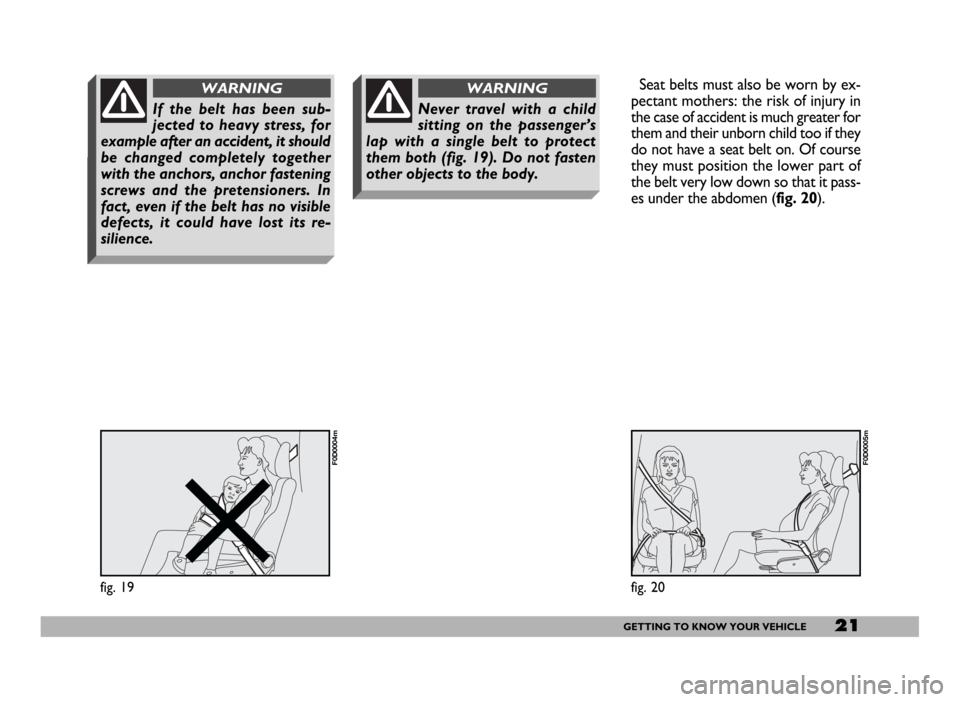
21GETTING TO KNOW YOUR VEHICLE
Seat belts must also be worn by ex-
pectant mothers: the risk of injury in
the case of accident is much greater for
them and their unborn child too if they
do not have a seat belt on. Of course
they must position the lower part of
the belt very low down so that it pass-
es under the abdomen (fig. 20).
fig. 19
F0D0004m
fig. 20
F0D0005m
If the belt has been sub-
jected to heavy stress, for
example after an accident, it should
be changed completely together
with the anchors, anchor fastening
screws and the pretensioners. In
fact, even if the belt has no visible
defects, it could have lost its re-
silience.
WARNING
Never travel with a child
sitting on the passenger’s
lap with a single belt to protect
them both (fig. 19). Do not fasten
other objects to the body.
WARNING
Page 23 of 258
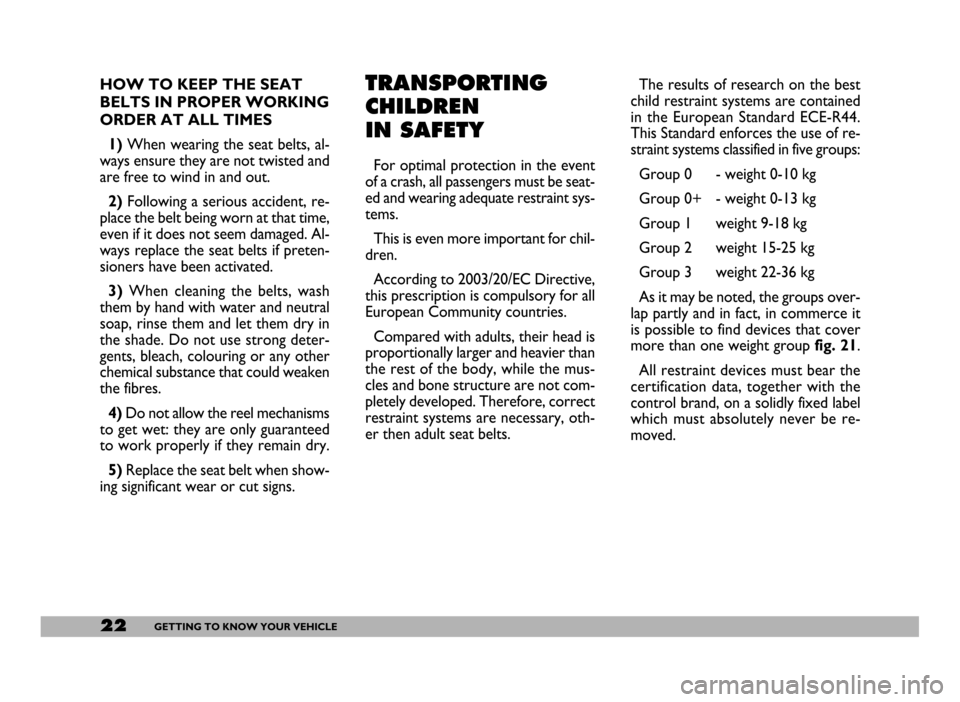
22GETTING TO KNOW YOUR VEHICLE
HOW TO KEEP THE SEAT
BELTS IN PROPER WORKING
ORDER AT ALL TIMES
1)When wearing the seat belts, al-
ways ensure they are not twisted and
are free to wind in and out.
2)Following a serious accident, re-
place the belt being worn at that time,
even if it does not seem damaged. Al-
ways replace the seat belts if preten-
sioners have been activated.
3)When cleaning the belts, wash
them by hand with water and neutral
soap, rinse them and let them dry in
the shade. Do not use strong deter-
gents, bleach, colouring or any other
chemical substance that could weaken
the fibres.
4)Do not allow the reel mechanisms
to get wet: they are only guaranteed
to work properly if they remain dry.
5)Replace the seat belt when show-
ing significant wear or cut signs.TRANSPORTING
CHILDREN
IN SAFETY
For optimal protection in the event
of a crash, all passengers must be seat-
ed and wearing adequate restraint sys-
tems.
This is even more important for chil-
dren.
According to 2003/20/EC Directive,
this prescription is compulsory for all
European Community countries.
Compared with adults, their head is
proportionally larger and heavier than
the rest of the body, while the mus-
cles and bone structure are not com-
pletely developed. Therefore, correct
restraint systems are necessary, oth-
er then adult seat belts.The results of research on the best
child restraint systems are contained
in the European Standard ECE-R44.
This Standard enforces the use of re-
straint systems classified in five groups:
Group 0 - weight 0-10 kg
Group 0+ - weight 0-13 kg
Group 1 weight 9-18 kg
Group 2 weight 15-25 kg
Group 3 weight 22-36 kg
As it may be noted, the groups over-
lap partly and in fact, in commerce it
is possible to find devices that cover
more than one weight group fig. 21.
All restraint devices must bear the
certification data, together with the
control brand, on a solidly fixed label
which must absolutely never be re-
moved.
Page 24 of 258
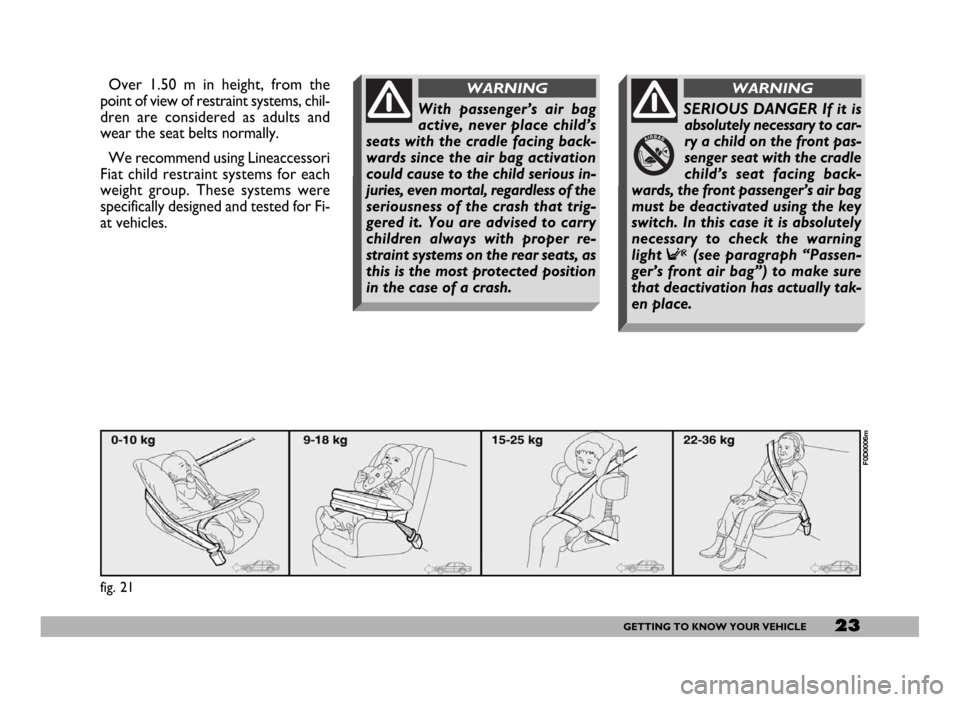
23GETTING TO KNOW YOUR VEHICLE
Over 1.50 m in height, from the
point of view of restraint systems, chil-
dren are considered as adults and
wear the seat belts normally.
We recommend using Lineaccessori
Fiat child restraint systems for each
weight group. These systems were
specifically designed and tested for Fi-
at vehicles.
fig. 21
F0D0006m
With passenger’s air bag
active, never place child’s
seats with the cradle facing back-
wards since the air bag activation
could cause to the child serious in-
juries, even mortal, regardless of the
seriousness of the crash that trig-
gered it. You are advised to carry
children always with proper re-
straint systems on the rear seats, as
this is the most protected position
in the case of a crash.
WARNING
SERIOUS DANGER If it is
absolutely necessary to car-
ry a child on the front pas-
senger seat with the cradle
child’s seat facing back-
wards, the front passenger’s air bag
must be deactivated using the key
switch. In this case it is absolutely
necessary to check the warning
light
F(see paragraph “Passen-
ger’s front air bag”) to make sure
that deactivation has actually tak-
en place.
WARNING
Page 25 of 258
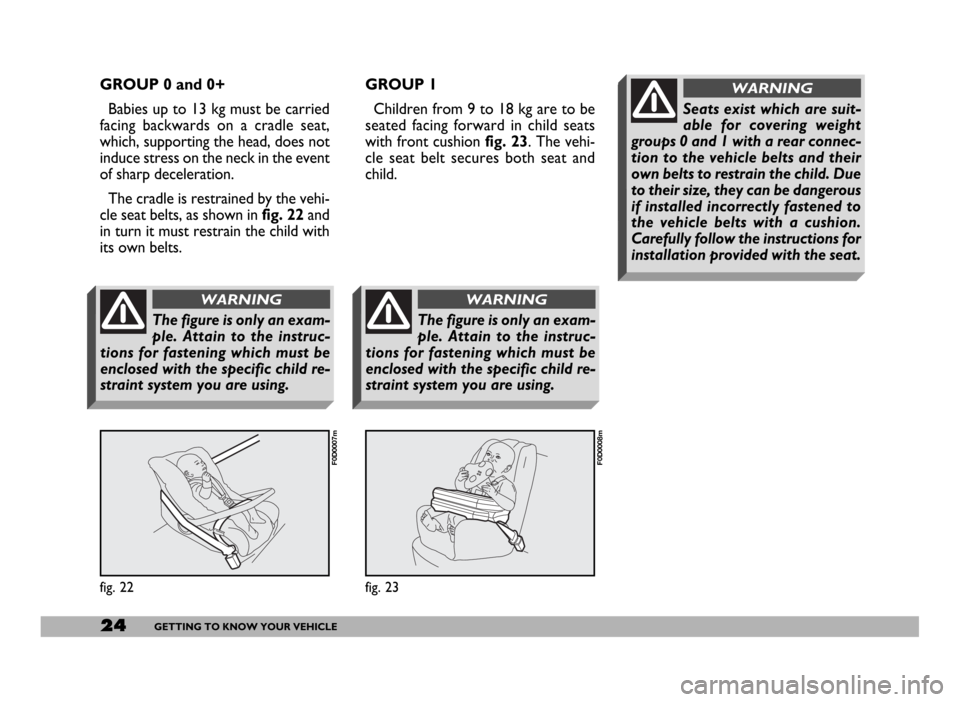
24GETTING TO KNOW YOUR VEHICLE
GROUP 0 and 0+
Babies up to 13 kg must be carried
facing backwards on a cradle seat,
which, supporting the head, does not
induce stress on the neck in the event
of sharp deceleration.
The cradle is restrained by the vehi-
cle seat belts, as shown infig. 22and
in turn it must restrain the child with
its own belts.GROUP 1
Children from 9 to 18 kg are to be
seated facing forward in child seats
with front cushionfig. 23. The vehi-
cle seat belt secures both seat and
child.
fig. 22
F0D0007m
fig. 23
F0D0008m
The figure is only an exam-
ple. Attain to the instruc-
tions for fastening which must be
enclosed with the specific child re-
straint system you are using.
WARNING
The figure is only an exam-
ple. Attain to the instruc-
tions for fastening which must be
enclosed with the specific child re-
straint system you are using.
WARNING
Seats exist which are suit-
able for covering weight
groups 0 and 1 with a rear connec-
tion to the vehicle belts and their
own belts to restrain the child. Due
to their size, they can be dangerous
if installed incorrectly fastened to
the vehicle belts with a cushion.
Carefully follow the instructions for
installation provided with the seat.
WARNING
Page 26 of 258
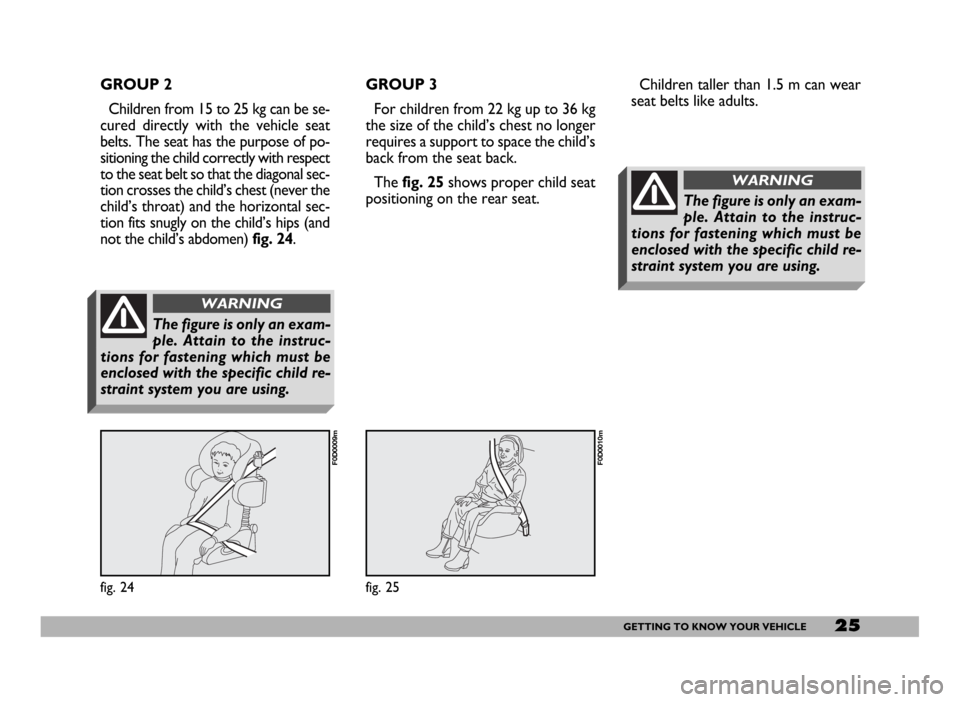
25GETTING TO KNOW YOUR VEHICLE
GROUP 2
Children from 15 to 25 kg can be se-
cured directly with the vehicle seat
belts. The seat has the purpose of po-
sitioning the child correctly with respect
to the seat belt so that the diagonal sec-
tion crosses the child’s chest (never the
child’s throat) and the horizontal sec-
tion fits snugly on the child’s hips (and
not the child’s abdomen) fig. 24.GROUP 3
For children from 22 kg up to 36 kg
the size of the child’s chest no longer
requires a support to space the child’s
back from the seat back.
The fig. 25shows proper child seat
positioning on the rear seat.
fig. 24
F0D0009m
fig. 25
F0D0010m
The figure is only an exam-
ple. Attain to the instruc-
tions for fastening which must be
enclosed with the specific child re-
straint system you are using.
WARNING
Children taller than 1.5 m can wear
seat belts like adults.
The figure is only an exam-
ple. Attain to the instruc-
tions for fastening which must be
enclosed with the specific child re-
straint system you are using.
WARNING
Page 27 of 258
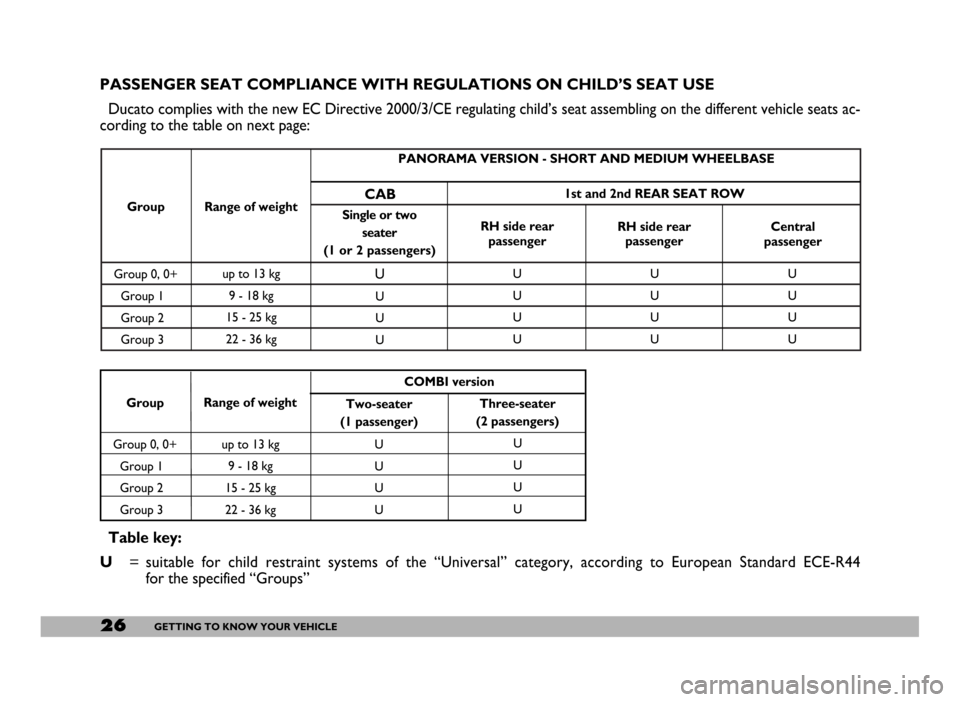
26GETTING TO KNOW YOUR VEHICLE
Group
Group Group 0, 0+
Group 1
Group 2
Group 3
Group 0, 0+
Group 1
Group 2
Group 3up to 13 kg
9 - 18 kg
15 - 25 kg
22 - 36 kg
up to 13 kg
9 - 18 kg
15 - 25 kg
22 - 36 kg
U
U
U
U
U
U
U
UU
U
U
U
U
U
U
UU
U
U
UU
U
U
U Range of weight
Range of weightSingle or two
seater
(1 or 2 passengers)
Two-seater
(1 passenger)RH side rear
passenger
Three-seater
(2 passengers)RH side rear
passengerCentral
passenger
COMBI version
PANORAMA VERSION - SHORT AND MEDIUM WHEELBASE
1st and 2nd REAR SEAT ROW
PASSENGER SEAT COMPLIANCE WITH REGULATIONS ON CHILD’S SEAT USE
Ducato complies with the new EC Directive 2000/3/CE regulating child’s seat assembling on the different vehicle seats ac-
cording to the table on next page:
Table key:
U= suitable for child restraint systems of the “Universal” category, according to European Standard ECE-R44
for the specified “Groups”
CAB
Page 28 of 258
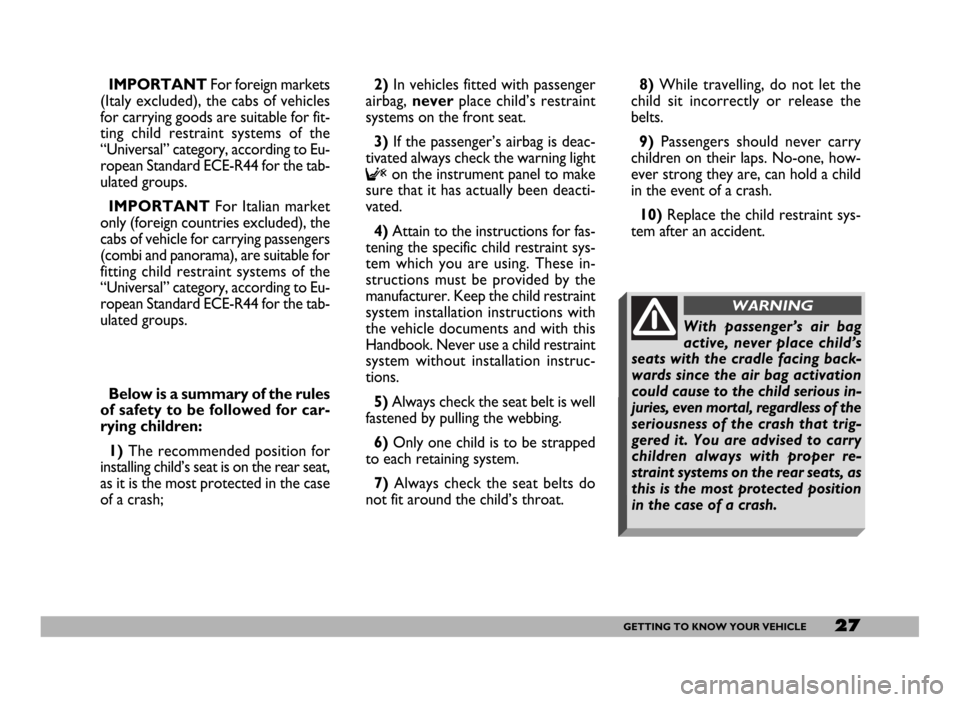
27GETTING TO KNOW YOUR VEHICLE
IMPORTANTFor foreign markets
(Italy excluded), the cabs of vehicles
for carrying goods are suitable for fit-
ting child restraint systems of the
“Universal” category, according to Eu-
ropean Standard ECE-R44 for the tab-
ulated groups.
IMPORTANTFor Italian market
only (foreign countries excluded), the
cabs of vehicle for carrying passengers
(combi and panorama), are suitable for
fitting child restraint systems of the
“Universal” category, according to Eu-
ropean Standard ECE-R44 for the tab-
ulated groups.
Below is a summary of the rules
of safety to be followed for car-
rying children:
1) The recommended position for
installing child’s seat is on the rear seat,
as it is the most protected in the case
of a crash;2) In vehicles fitted with passenger
airbag, neverplace child’s restraint
systems on the front seat.
3) If the passenger’s airbag is deac-
tivated always check the warning light
Fon the instrument panel to make
sure that it has actually been deacti-
vated.
4) Attain to the instructions for fas-
tening the specific child restraint sys-
tem which you are using. These in-
structions must be provided by the
manufacturer. Keep the child restraint
system installation instructions with
the vehicle documents and with this
Handbook. Never use a child restraint
system without installation instruc-
tions.
5) Always check the seat belt is well
fastened by pulling the webbing.
6) Only one child is to be strapped
to each retaining system.
7) Always check the seat belts do
not fit around the child’s throat.8) While travelling, do not let the
child sit incorrectly or release the
belts.
9)Passengers should never carry
children on their laps. No-one, how-
ever strong they are, can hold a child
in the event of a crash.
10) Replace the child restraint sys-
tem after an accident.
With passenger’s air bag
active, never place child’s
seats with the cradle facing back-
wards since the air bag activation
could cause to the child serious in-
juries, even mortal, regardless of the
seriousness of the crash that trig-
gered it. You are advised to carry
children always with proper re-
straint systems on the rear seats, as
this is the most protected position
in the case of a crash.
WARNING
Page 45 of 258
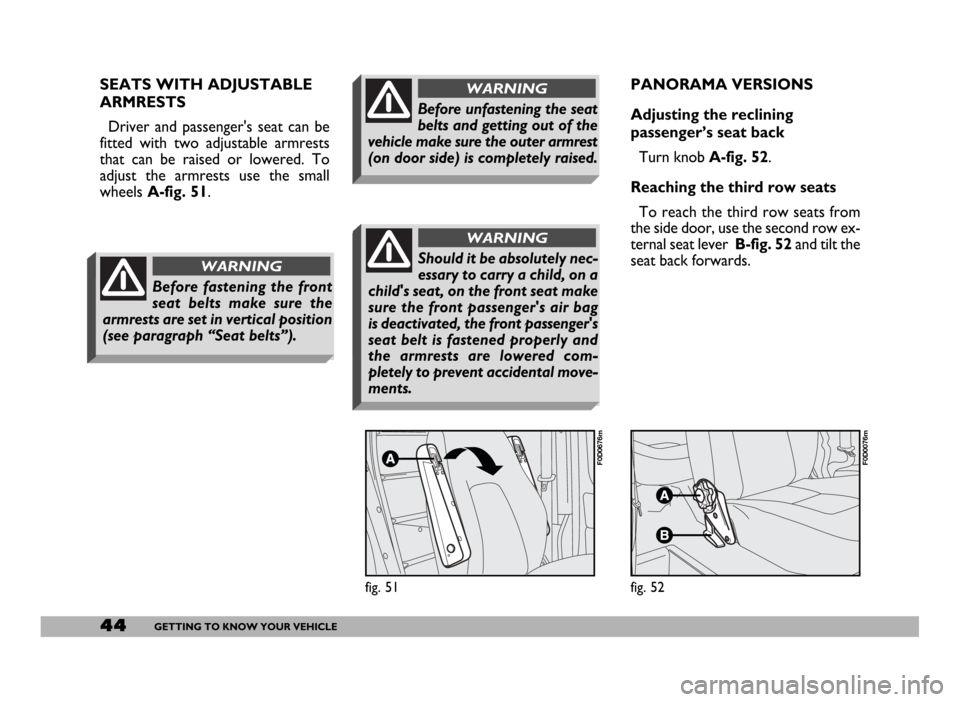
44GETTING TO KNOW YOUR VEHICLE
PANORAMA VERSIONS
Adjusting the reclining
passenger’s seat back
Turn knobA-fig. 52.
Reaching the third row seats
To reach the third row seats from
the side door, use the second row ex-
ternal seat lever B-fig. 52and tilt the
seat back forwards.
fig. 52
F0D0076m
SEATS WITH ADJUSTABLE
ARMRESTS
Driver and passenger's seat can be
fitted with two adjustable armrests
that can be raised or lowered. To
adjust the armrests use the small
wheels A-fig. 51.
fig. 51
F0D0676m
Should it be absolutely nec-
essary to carry a child, on a
child's seat, on the front seat make
sure the front passenger's air bag
is deactivated, the front passenger's
seat belt is fastened properly and
the armrests are lowered com-
pletely to prevent accidental move-
ments.
WARNING
Before fastening the front
seat belts make sure the
armrests are set in vertical position
(see paragraph “Seat belts”).
WARNING
Before unfastening the seat
belts and getting out of the
vehicle make sure the outer armrest
(on door side) is completely raised.
WARNING
Page 92 of 258
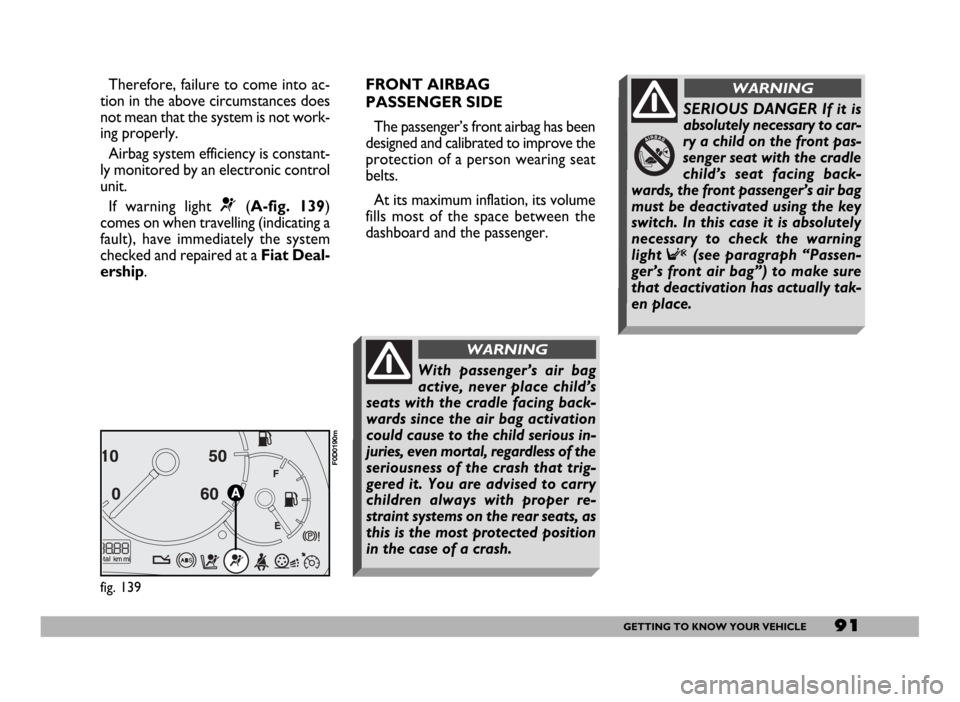
91GETTING TO KNOW YOUR VEHICLE
Therefore, failure to come into ac-
tion in the above circumstances does
not mean that the system is not work-
ing properly.
Airbag system efficiency is constant-
ly monitored by an electronic control
unit.
If warning light
¬(A-fig. 139)
comes on when travelling (indicating a
fault), have immediately the system
checked and repaired at a Fiat Deal-
ership.FRONT AIRBAG
PASSENGER SIDE
The passenger’s front airbag has been
designed and calibrated to improve the
protection of a person wearing seat
belts.
At its maximum inflation, its volume
fills most of the space between the
dashboard and the passenger.
fig. 139
F0D0190m
SERIOUS DANGER If it is
absolutely necessary to car-
ry a child on the front pas-
senger seat with the cradle
child’s seat facing back-
wards, the front passenger’s air bag
must be deactivated using the key
switch. In this case it is absolutely
necessary to check the warning
light
F(see paragraph “Passen-
ger’s front air bag”) to make sure
that deactivation has actually tak-
en place.
WARNING
With passenger’s air bag
active, never place child’s
seats with the cradle facing back-
wards since the air bag activation
could cause to the child serious in-
juries, even mortal, regardless of the
seriousness of the crash that trig-
gered it. You are advised to carry
children always with proper re-
straint systems on the rear seats, as
this is the most protected position
in the case of a crash.
WARNING
Page 93 of 258
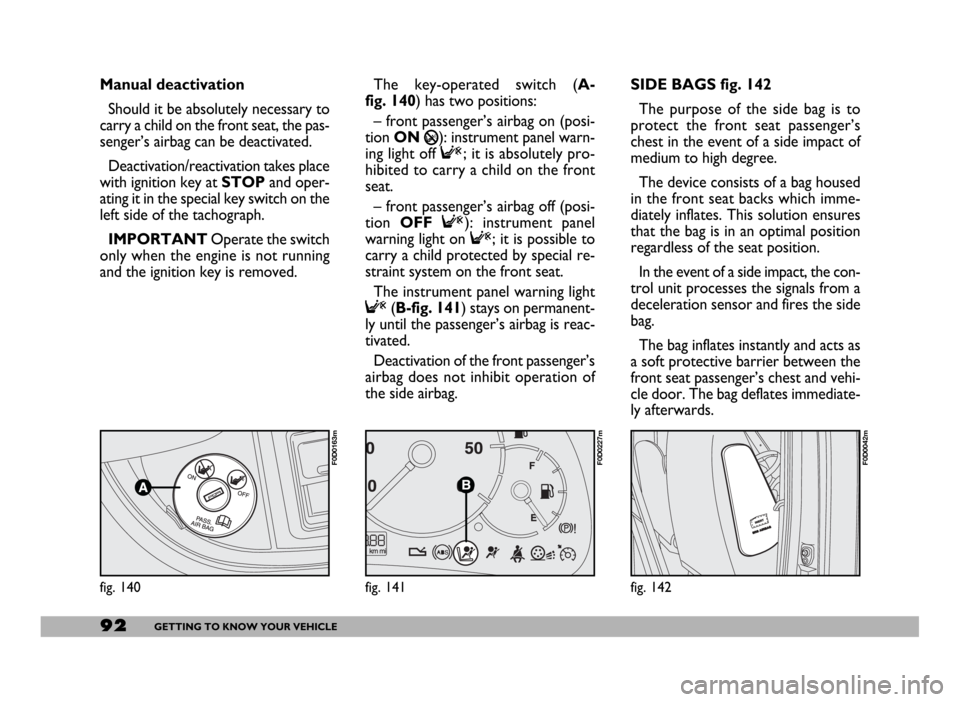
92GETTING TO KNOW YOUR VEHICLE
SIDE BAGS fig. 142
The purpose of the side bag is to
protect the front seat passenger’s
chest in the event of a side impact of
medium to high degree.
The device consists of a bag housed
in the front seat backs which imme-
diately inflates. This solution ensures
that the bag is in an optimal position
regardless of the seat position.
In the event of a side impact, the con-
trol unit processes the signals from a
deceleration sensor and fires the side
bag.
The bag inflates instantly and acts as
a soft protective barrier between the
front seat passenger’s chest and vehi-
cle door. The bag deflates immediate-
ly afterwards.
fig. 142
F0D0042m
fig. 140
F0D0163m
Manual deactivation
Should it be absolutely necessary to
carry a child on the front seat, the pas-
senger’s airbag can be deactivated.
Deactivation/reactivation takes place
with ignition key at STOPand oper-
ating it in the special key switch on the
left side of the tachograph.
IMPORTANTOperate the switch
only when the engine is not running
and the ignition key is removed.The key-operated switch (A-
fig. 140) has two positions:
– front passenger’s airbag on (posi-
tion ON
P): instrument panel warn-
ing light off F; it is absolutely pro-
hibited to carry a child on the front
seat.
– front passenger’s airbag off (posi-
tion OFF F): instrument panel
warning light on F; it is possible to
carry a child protected by special re-
straint system on the front seat.
The instrument panel warning light
F(B-fig. 141) stays on permanent-
ly until the passenger’s airbag is reac-
tivated.
Deactivation of the front passenger’s
airbag does not inhibit operation of
the side airbag.
fig. 141
F0D0227m